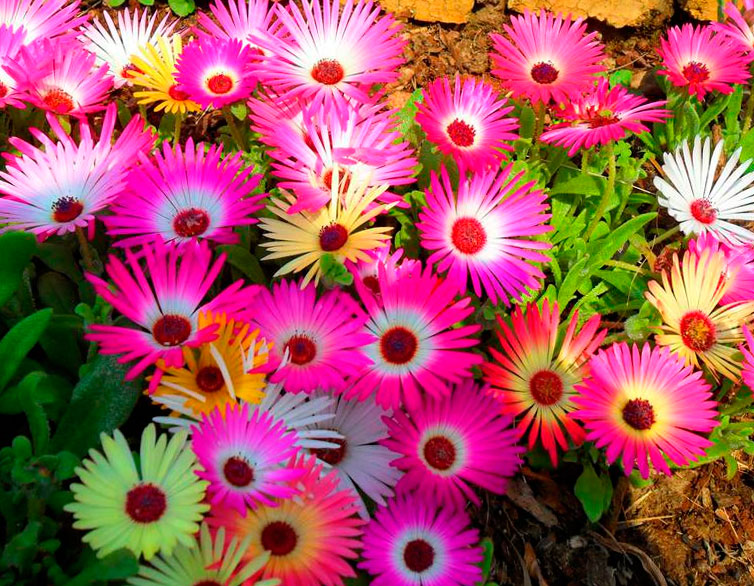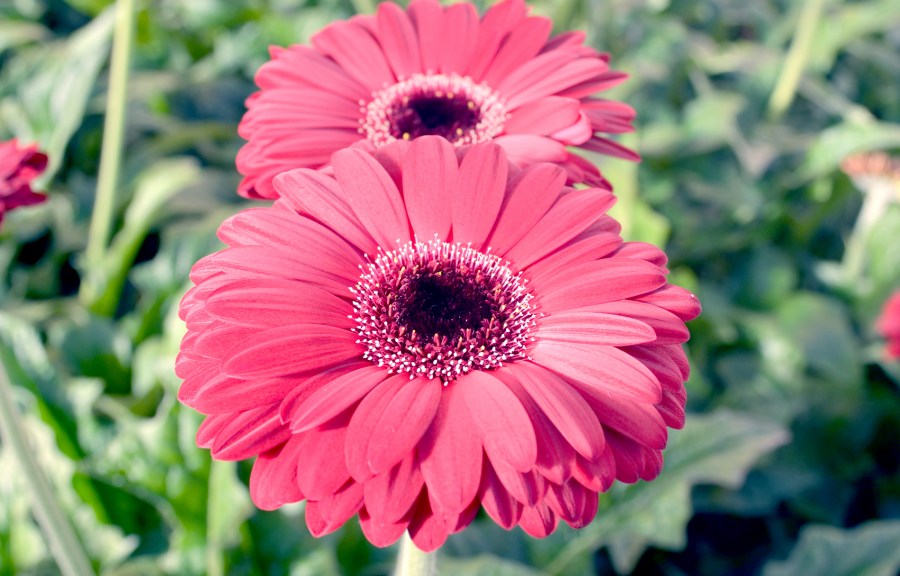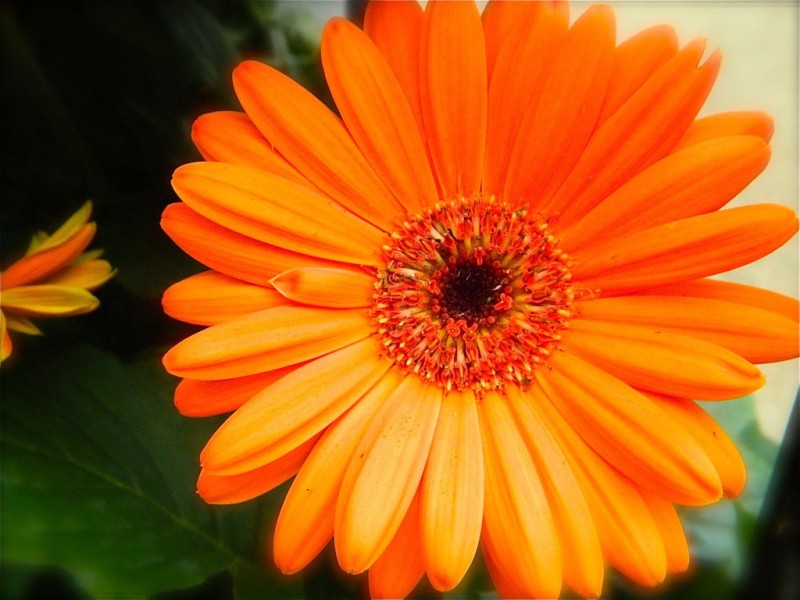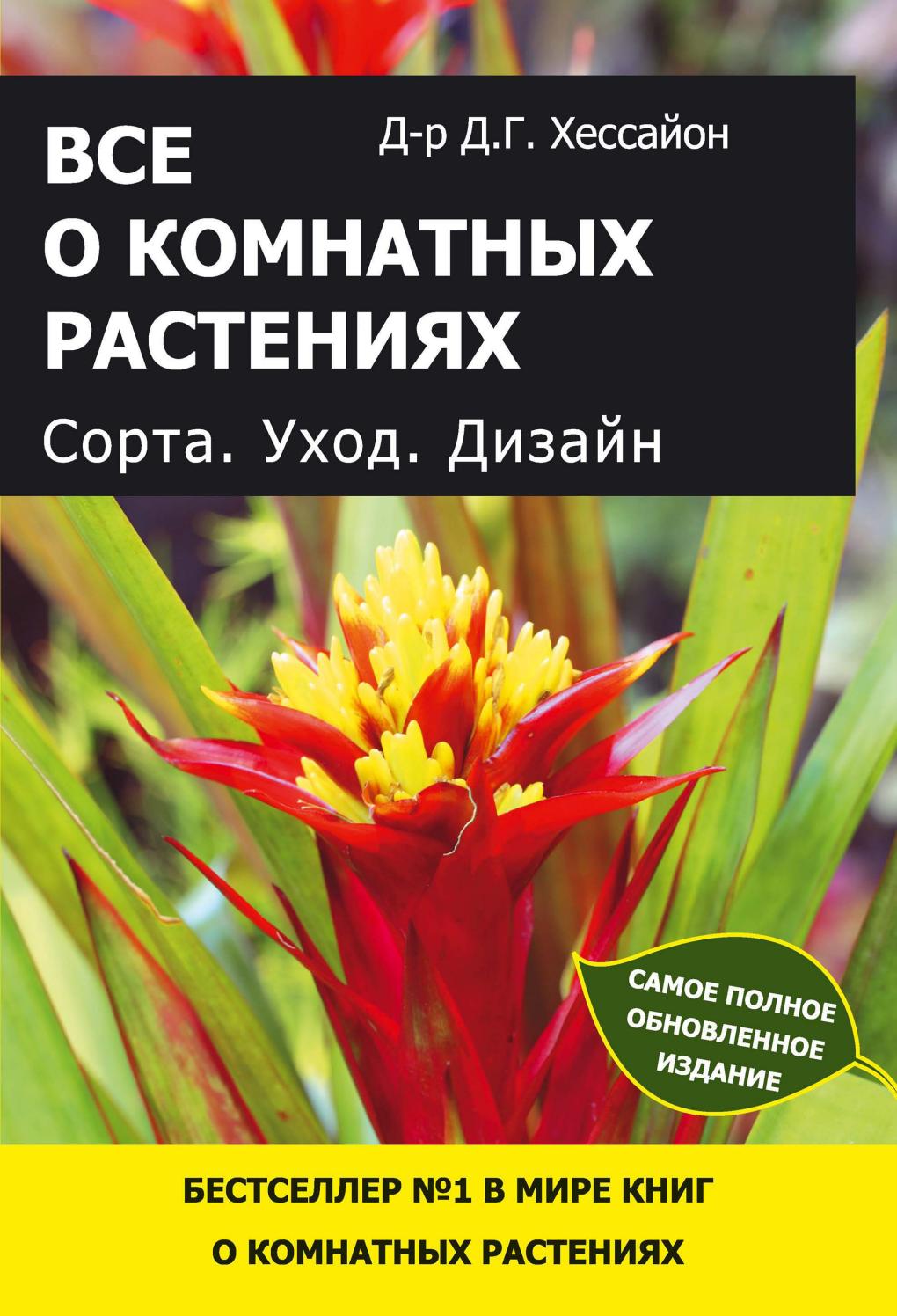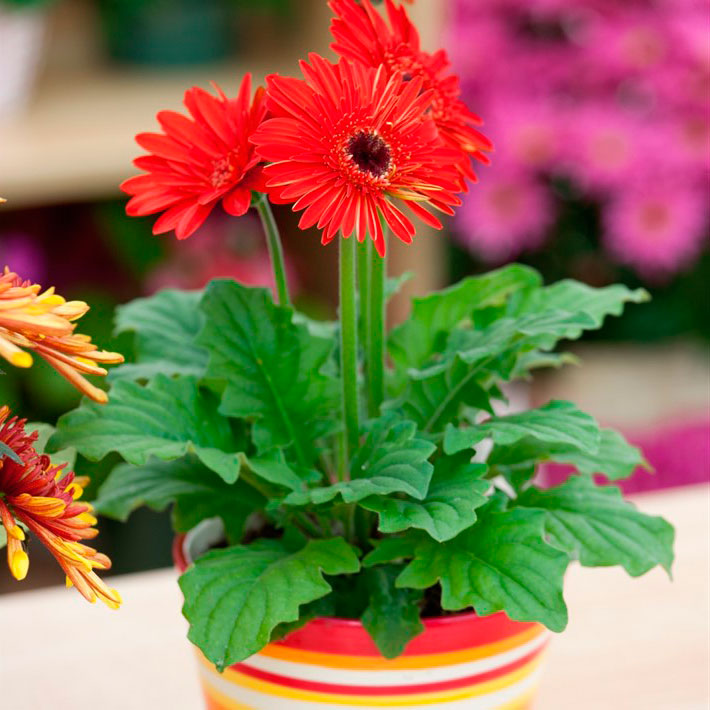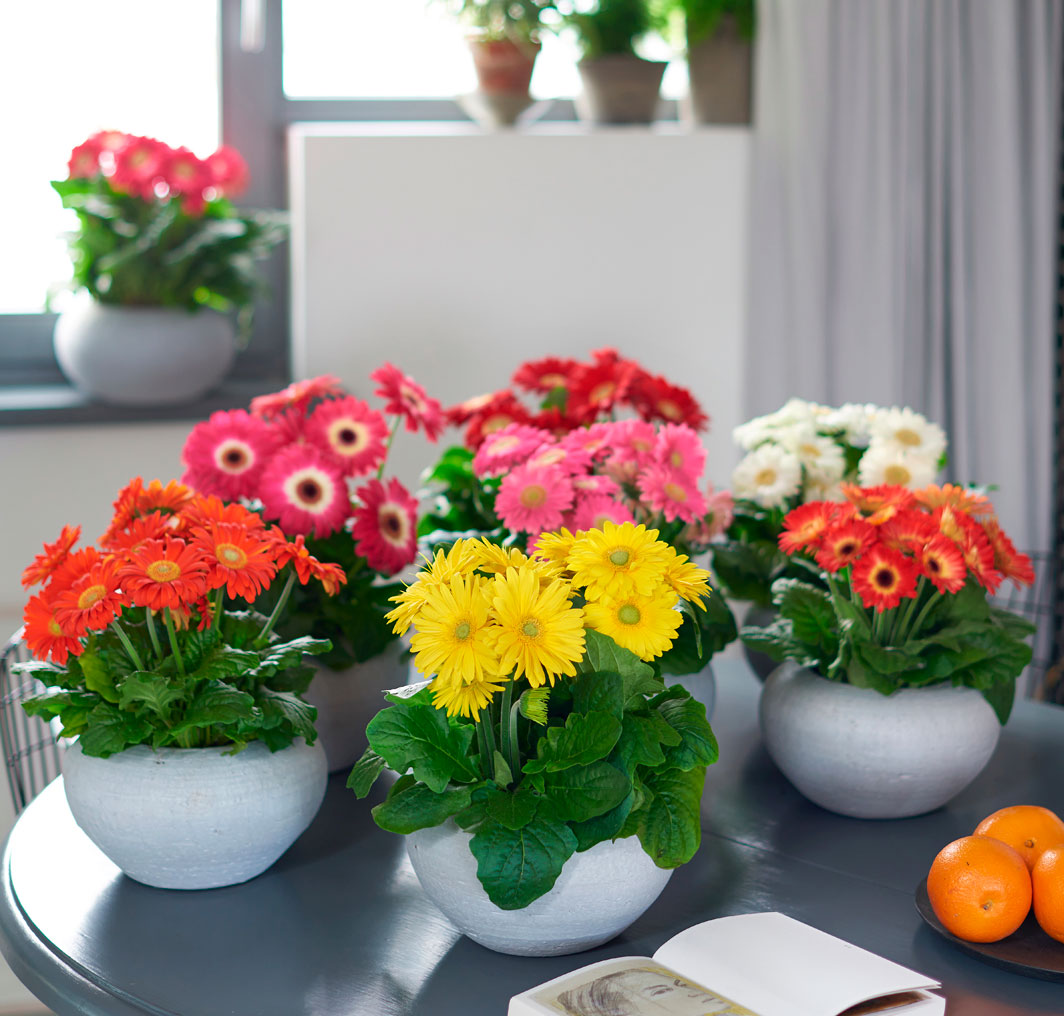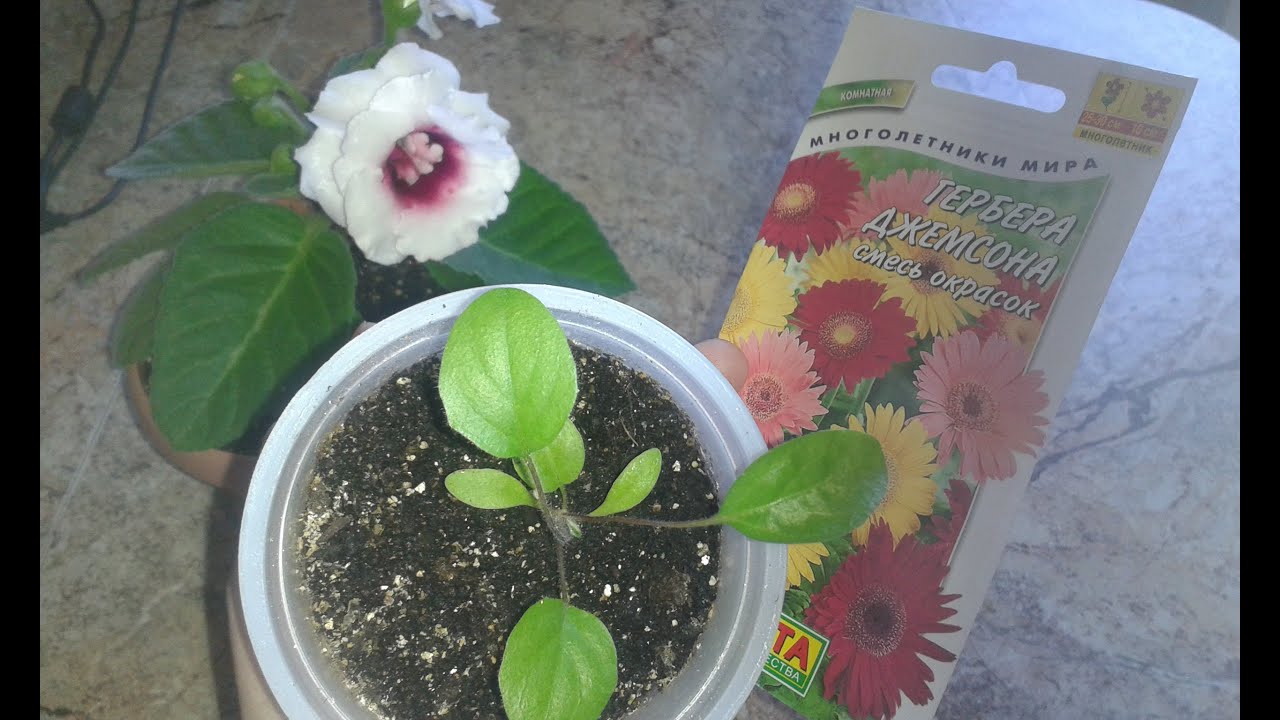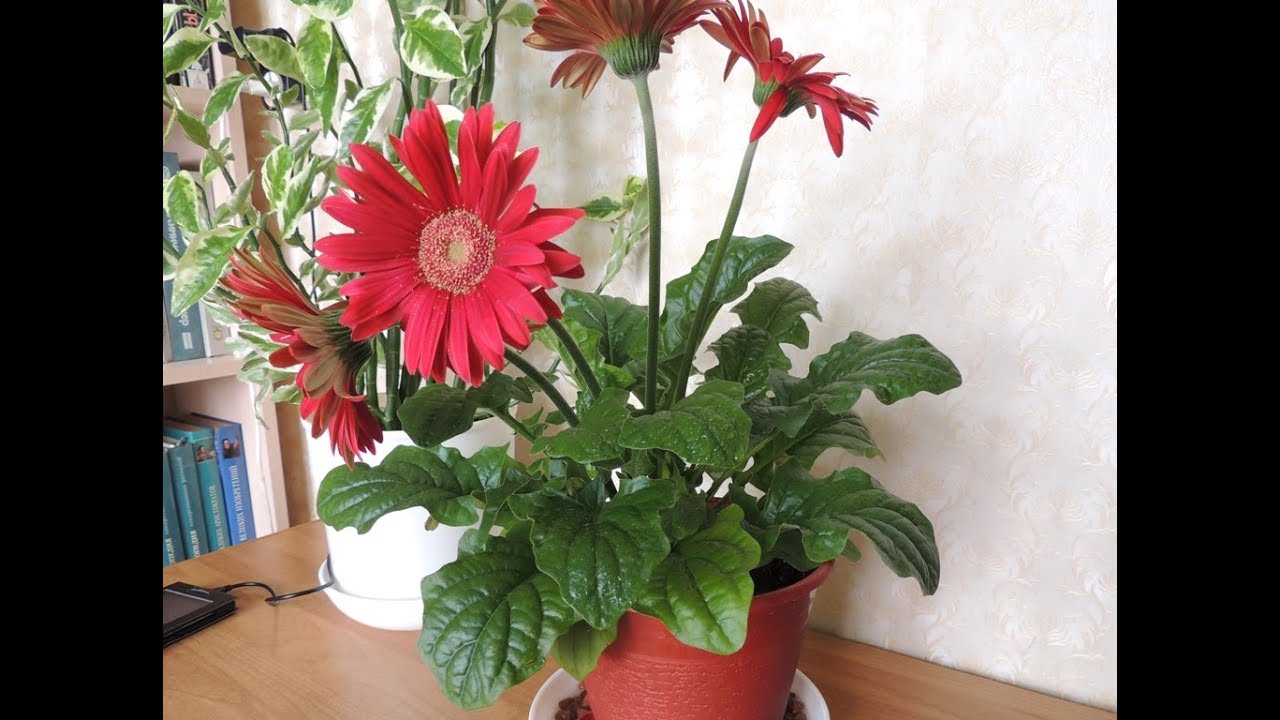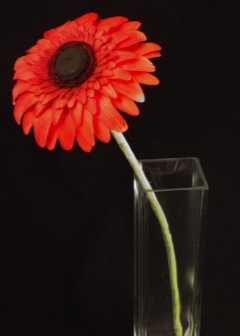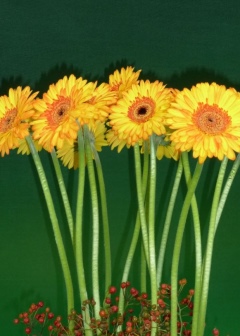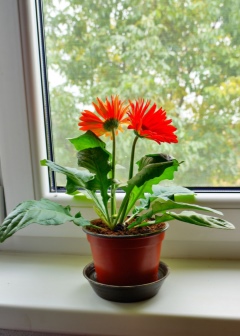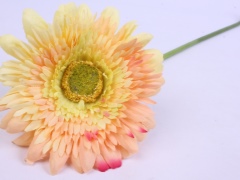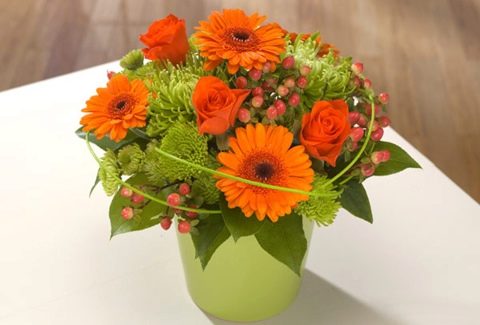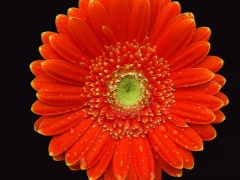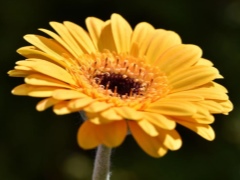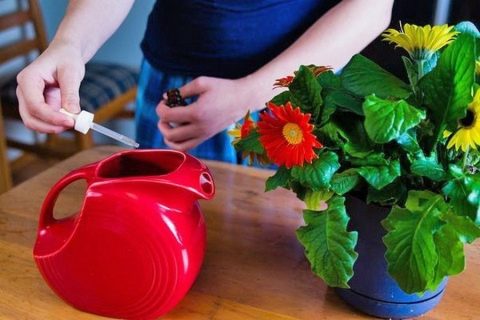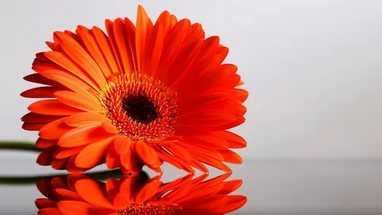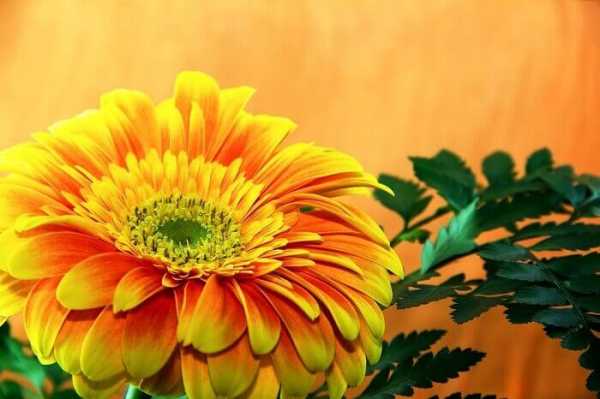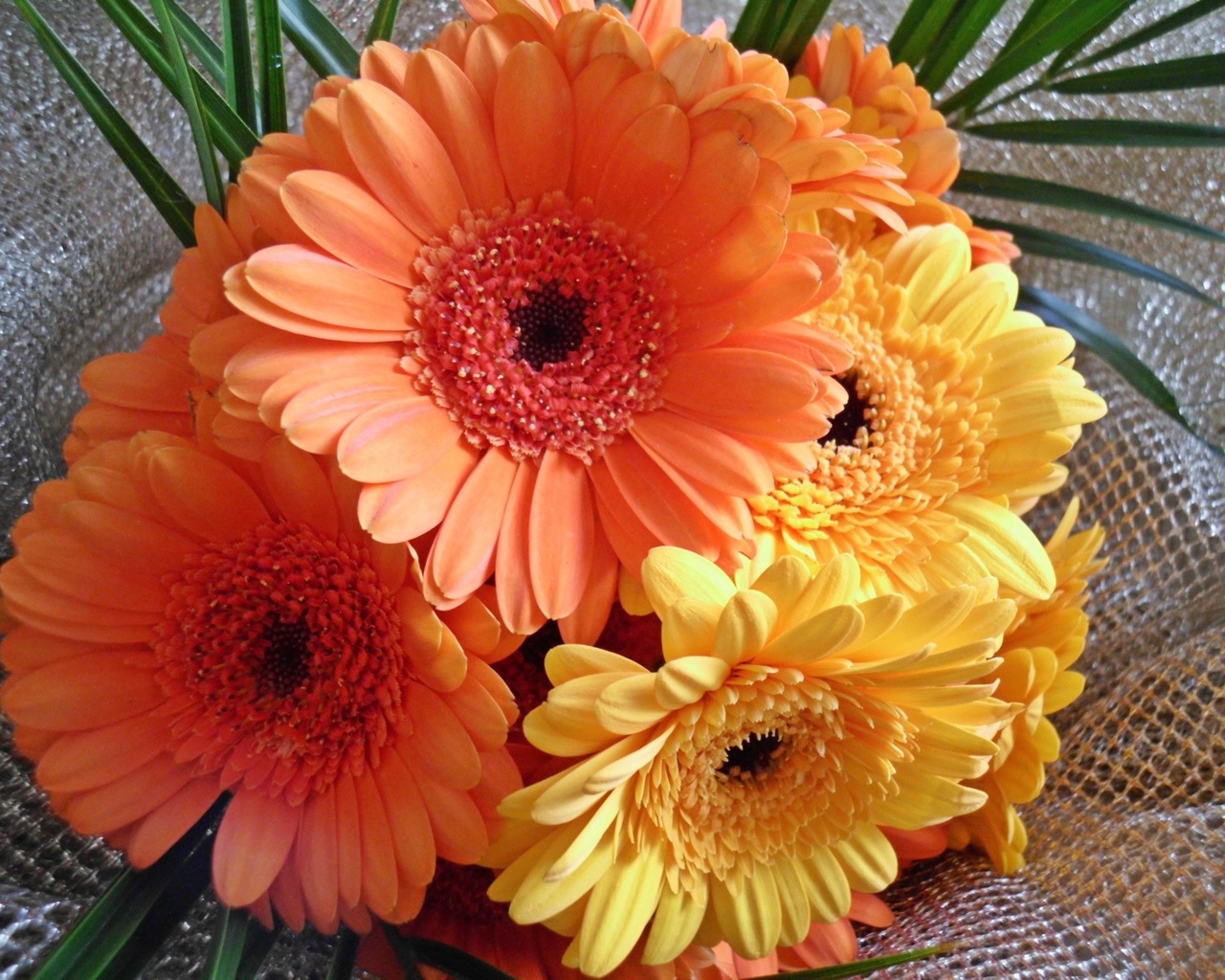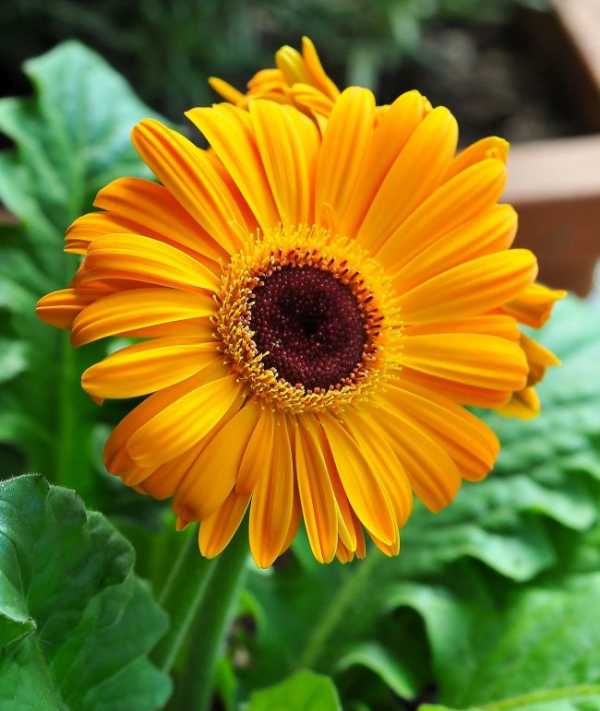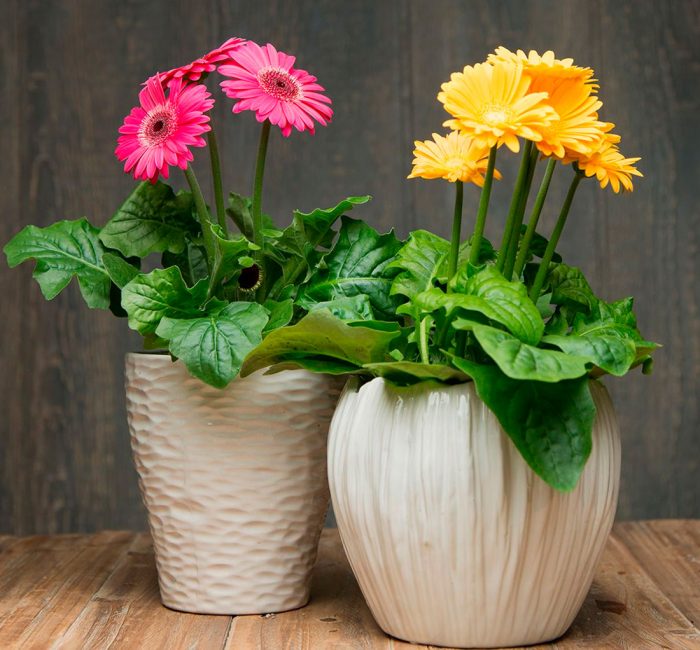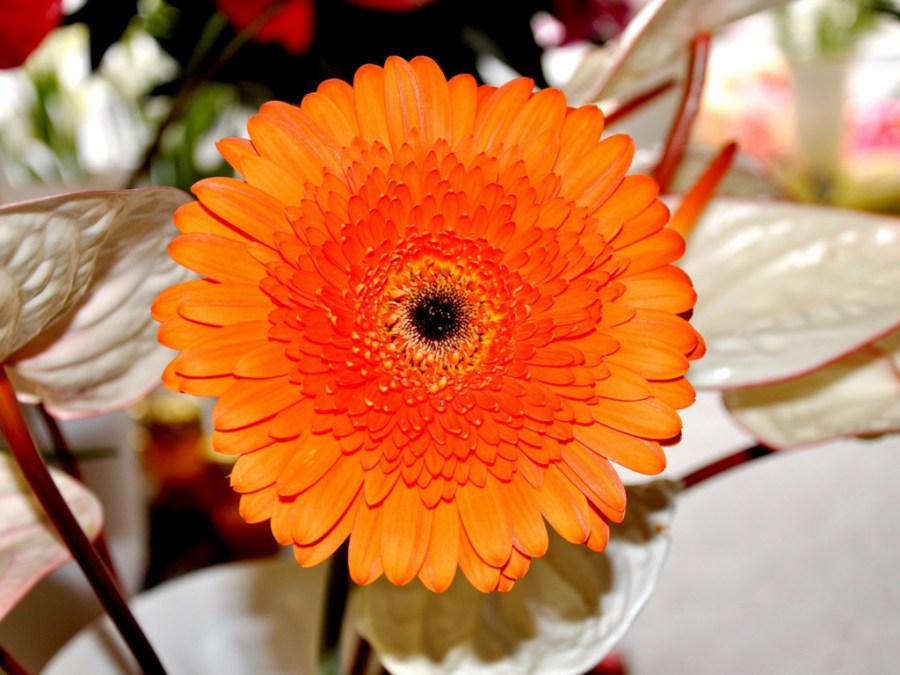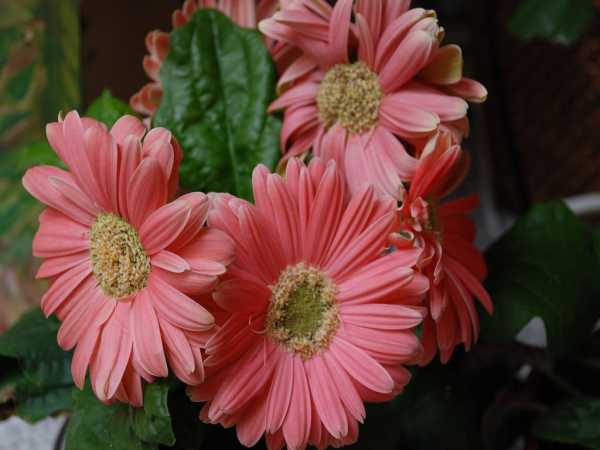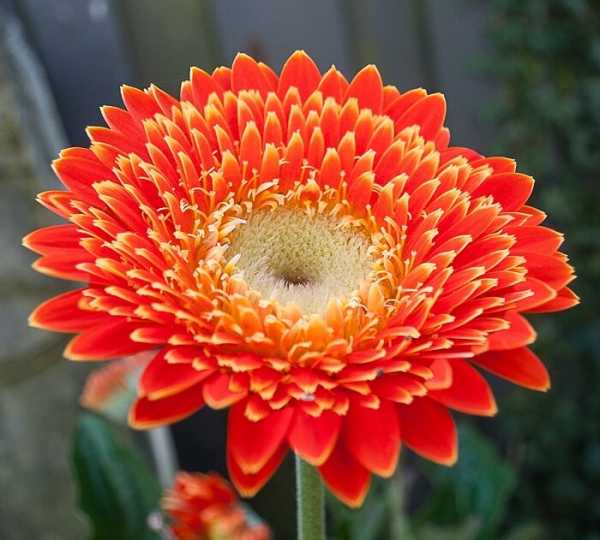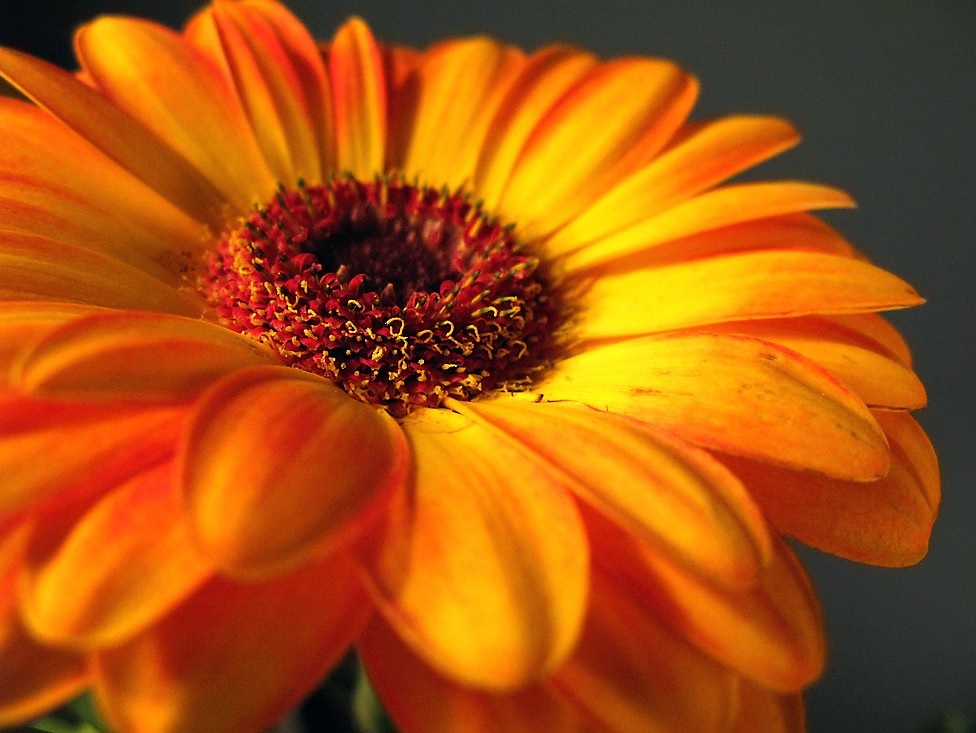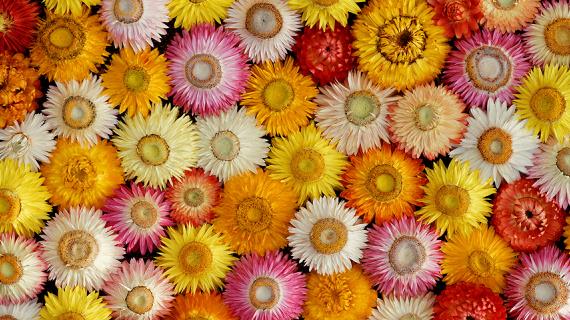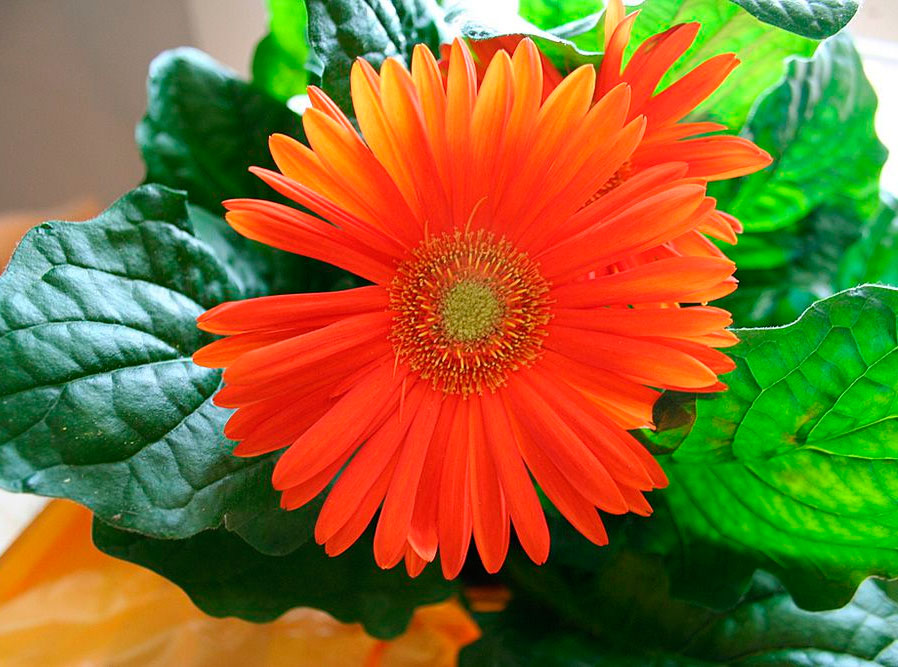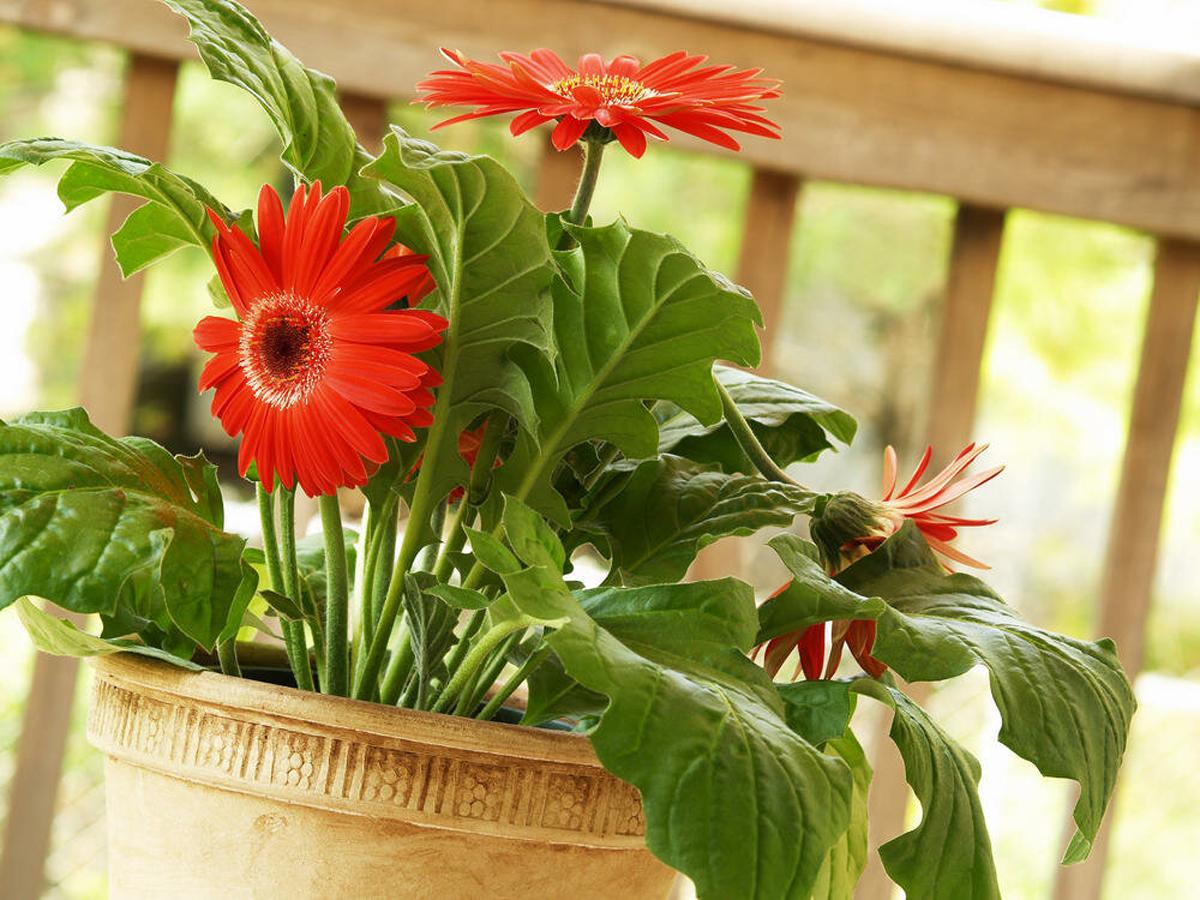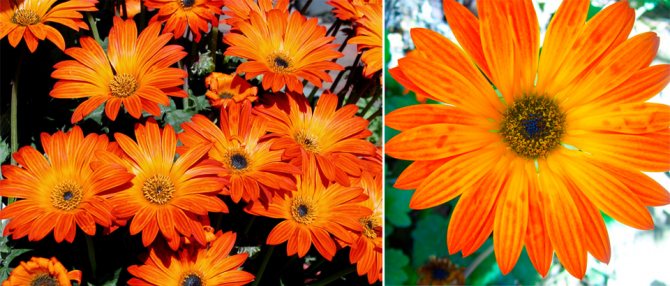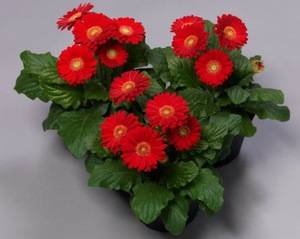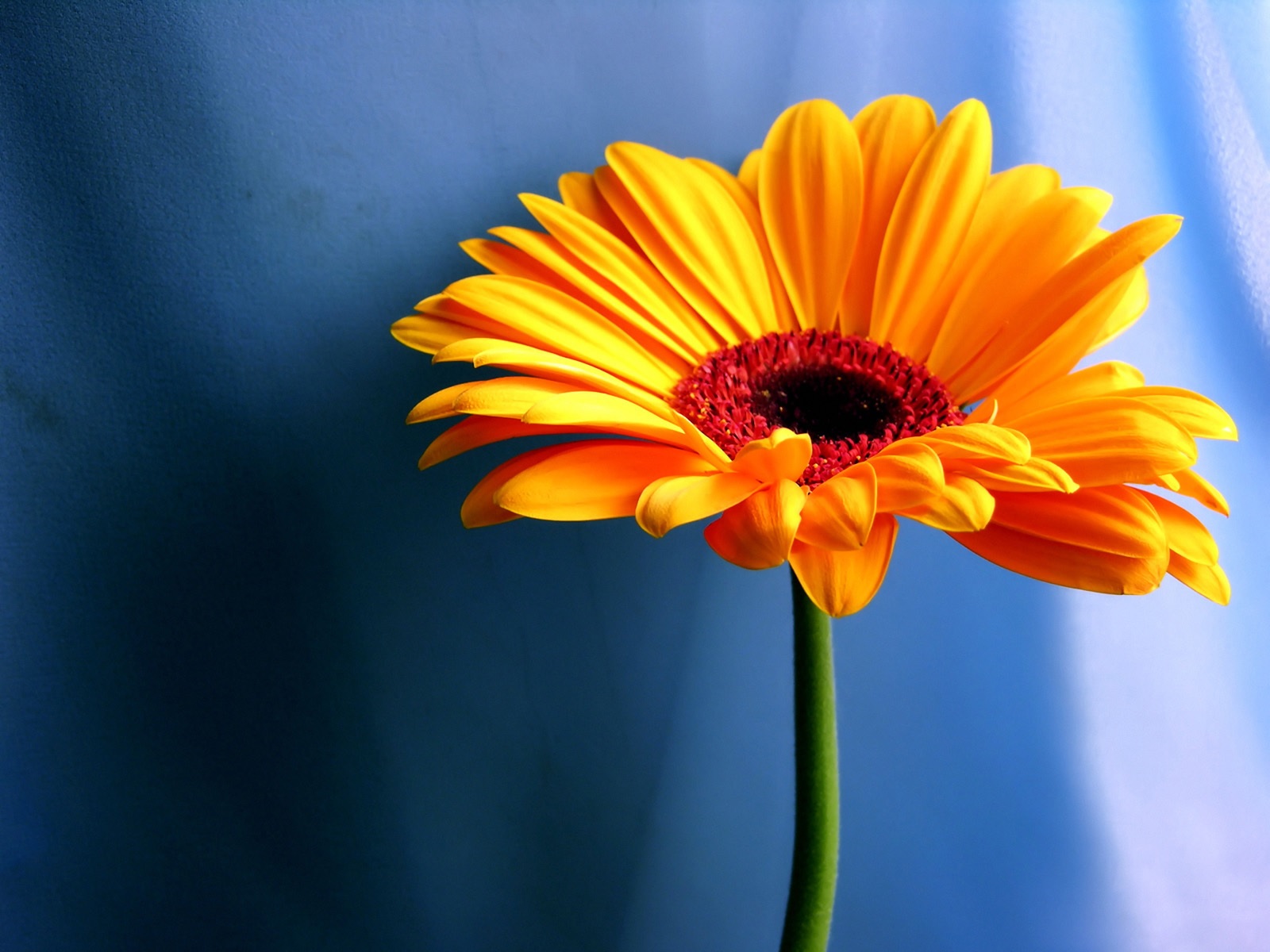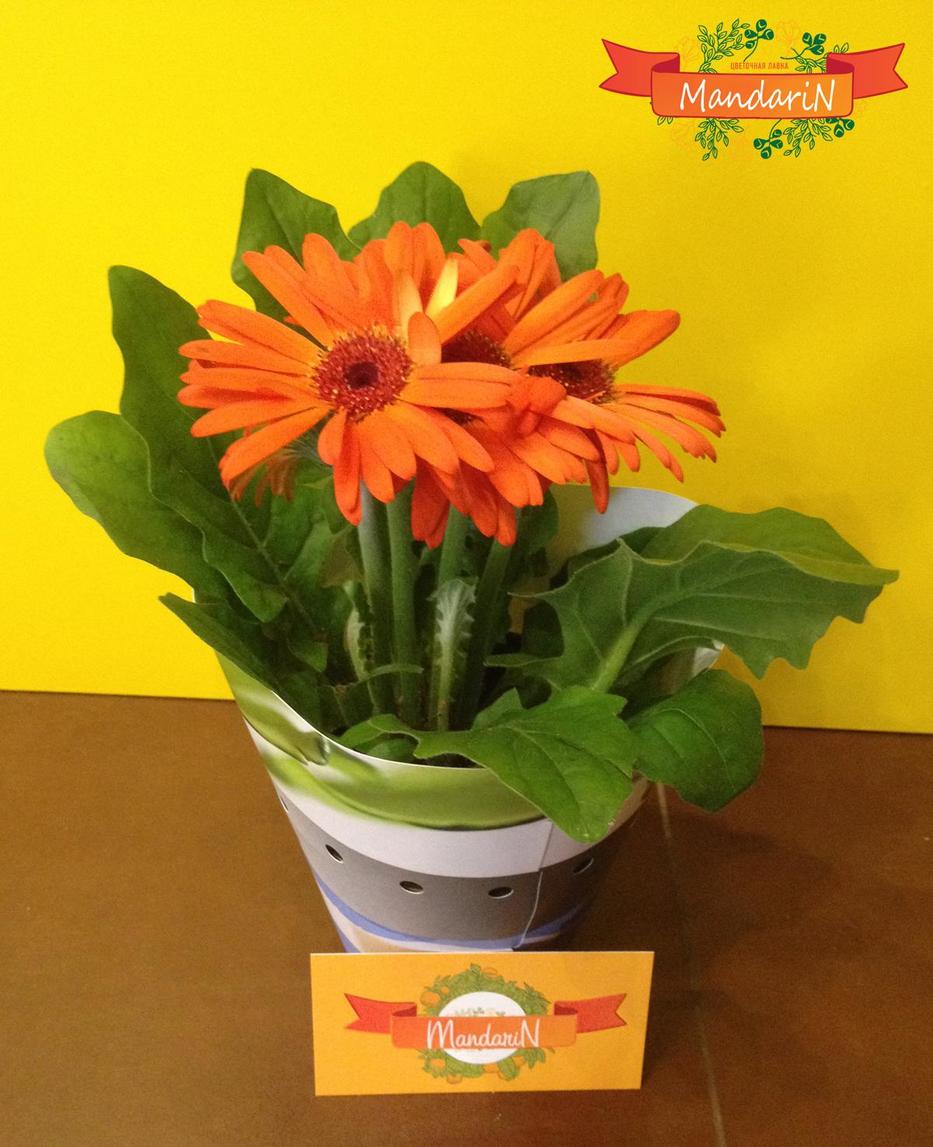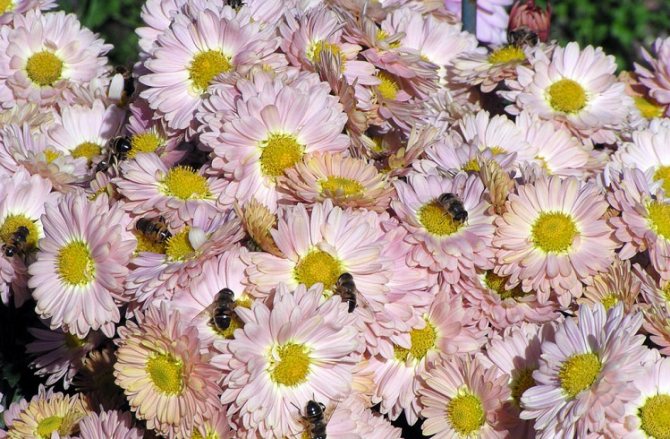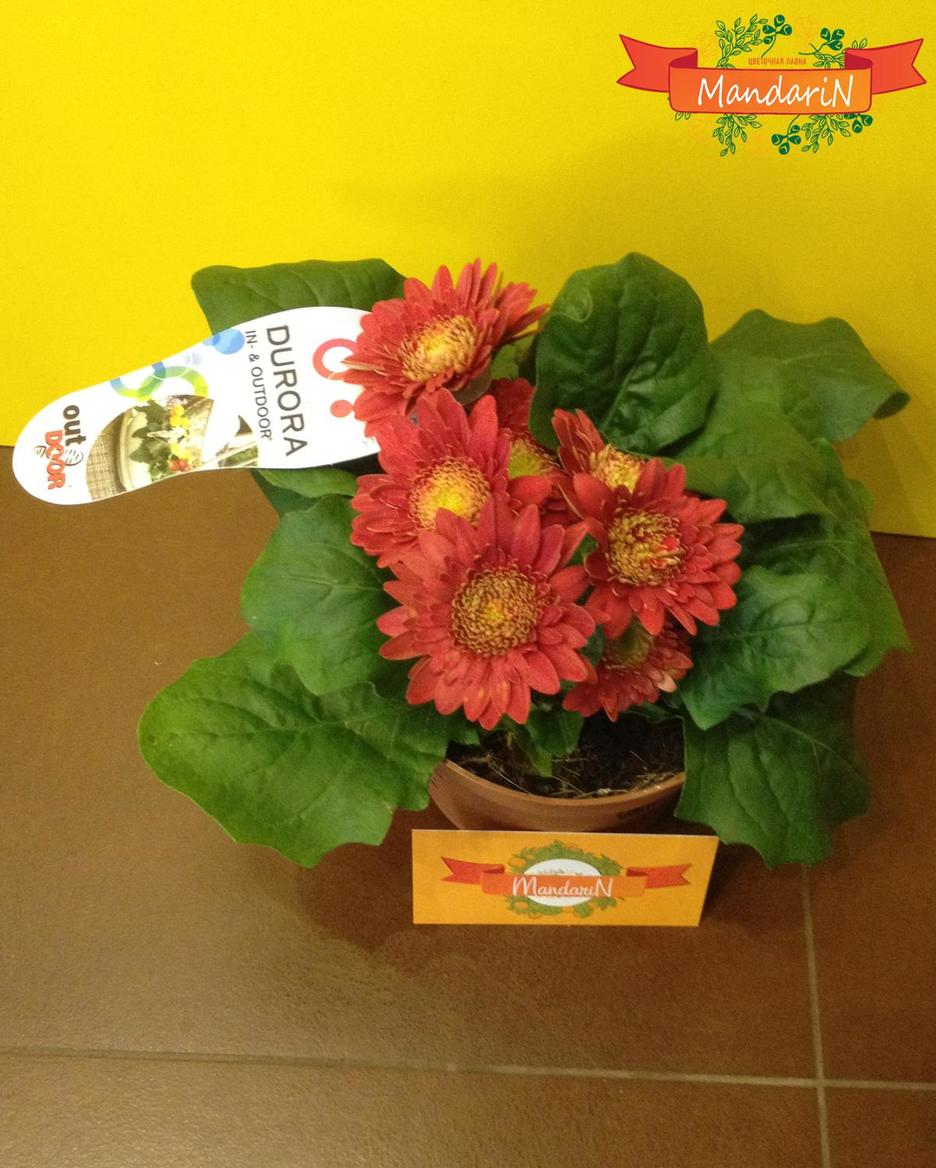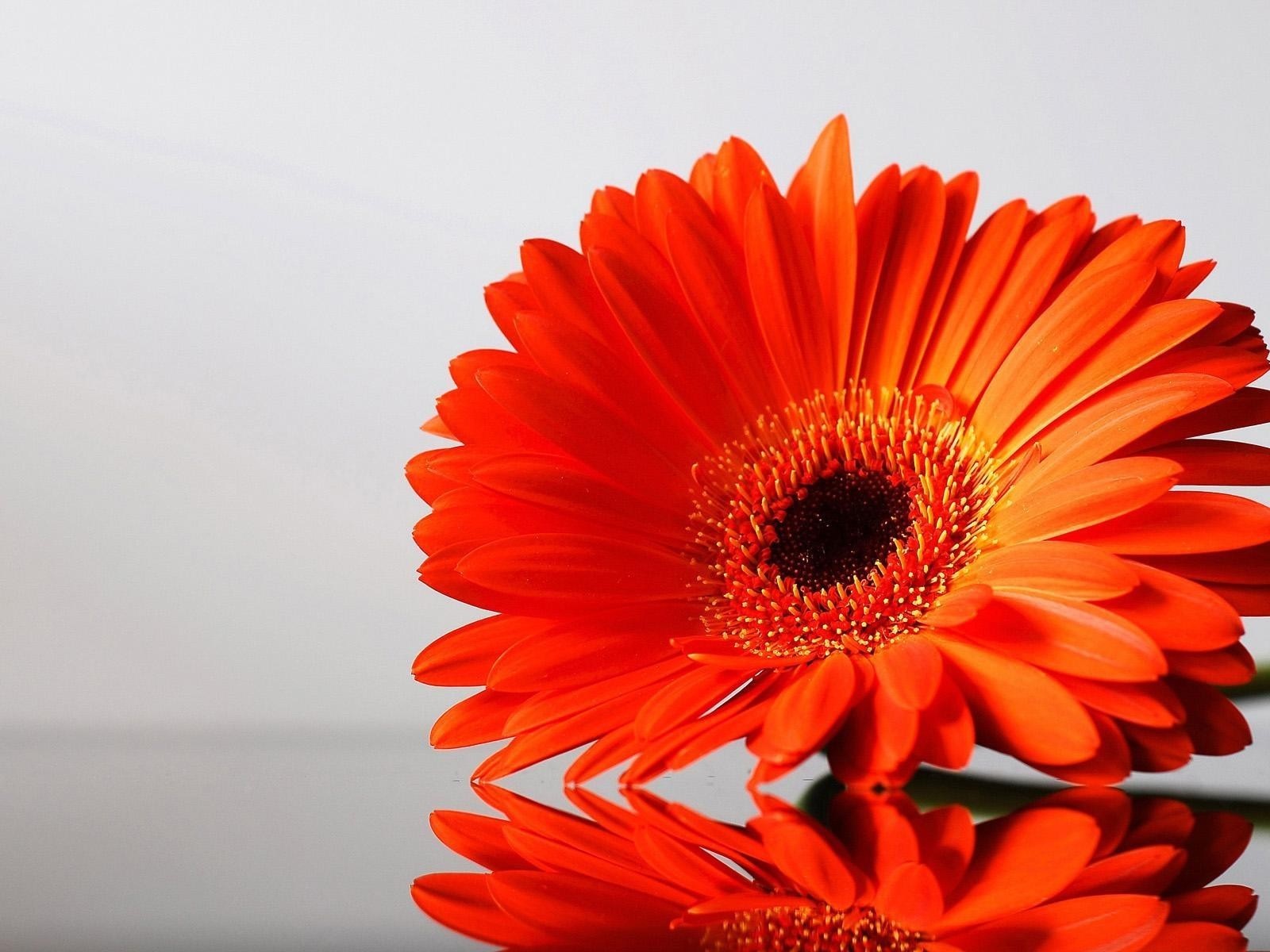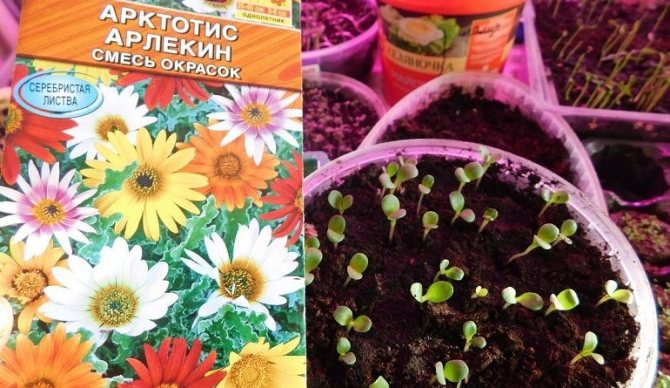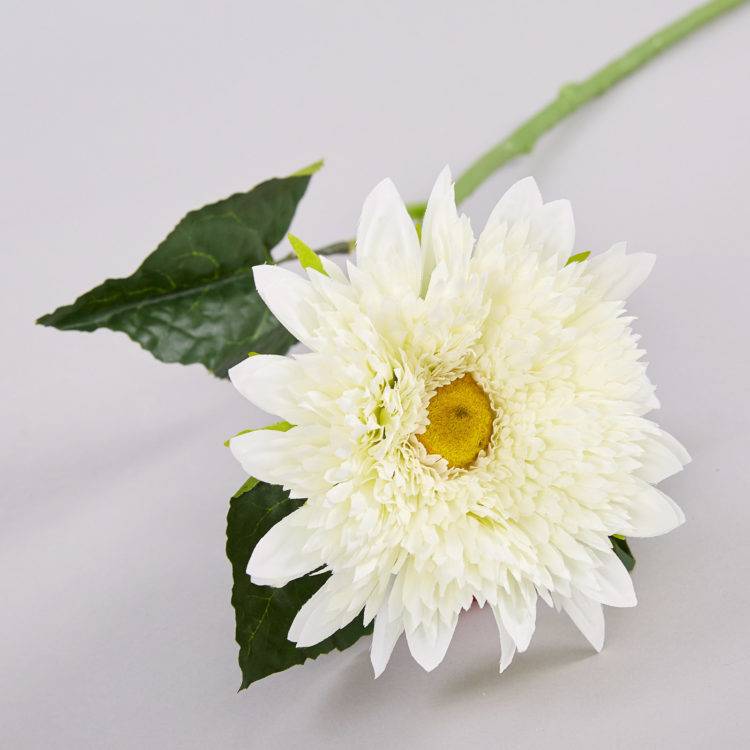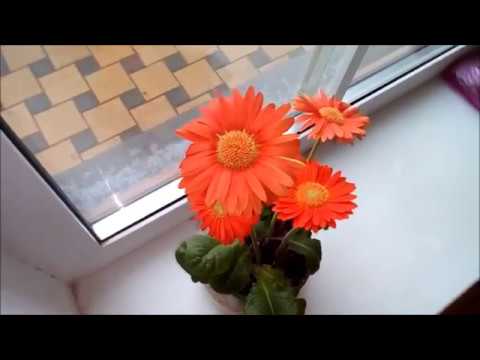How and where to plant?
The orange gerbera is planted in open ground with seedlings. For the first time, it may seem difficult to carry out this procedure, but over time, a novice gardener will get used to it (we will tell you in detail here how gerberas are properly planted in open ground and what kind of subsequent care they need).
The order of planting flowers
Purchase of planting material. If you have grown gerberas before, you can collect seeds from the box
If you have just decided to acquire these flowers, then the seeds can be purchased in a specialized store. We recommend choosing only trusted manufacturers and paying special attention to the expiration dates.
To determine the date of planting, be guided by the fact that gerberas begin to bloom after a year of growth and development.
The seedling boxes do not need to be deep, as soon you will have to dive the seedlings. Do not forget about a good drainage layer.
To prepare the soil mixture for seedlings yourself, you need to take sand, humus and leafy soil in equal proportions. But it would be better to buy a ready-made substrate in a flower shop.
Soil is perfect for roses.
It will not be superfluous to pour the prepared mixture with a solution of potassium permanganate.
The seed is planted, leaving a square of 2 centimeters for each seed and pressing them slightly.
A place for seedlings is chosen warm and dark.
Seedlings usually show up after seven days.
After the first three leaves appear, the seedlings can be dived into separate containers.
As soon as you notice more than five leaves, you need to pick a second time, using deeper pots (their diameter should reach 10-12 cm).
Do not forget to feed the seedlings with mineral fertilizers at least once every 15 days.
It is possible to plant seedlings in open ground only after the night temperature outside stops dropping below 18 degrees. All the nuances of growing gerberas from seeds are described in detail in this material.
Lighting and location
The orange gerbera is a plant that requires a lot of light. Therefore, when choosing the location of the flower, it is better to give preference to the southern, in extreme cases - to the eastern sides. In the northern part of the room, the flower will feel a constant lack of light.
In the warm season, it will be very useful to take the gerbera out into the open air.
It is necessary to accustom the plant to a new temperature and light regime gradually.
In autumn and winter, it is worth thinking about additional lighting for the "home sun".
Soil requirements
Gerbera has no special preferences about soil at all.
The main thing is that the substrate should be loosened, easily let through air and have a neutral pH environment, while the level of organic matter should not be high.
You can take any universal soil, adding vermiculite and charcoal, peat, leafy earth and sand there. If these additives are not used, you will protect the plant from root decay. But in this case, you will need to regularly feed the flowers. An important condition for the good development of gerbera is the presence of a drainage layer, which can be created using expanded clay, pebbles or crushed shells.
Decorative varieties for growing on pots
There are about 80 plant varieties. In indoor conditions, compact varieties of Jameson's gerbera most often take root. The key distinguishing feature is a low peduncle, up to 30 cm. There are also forms of the classic green-leaved gerbera, which are more suitable for the garden, as well as Gerbera Wright, Abyssinian, Ferruginea DC, etc.
The varieties of the plant are distinguished by the beautiful shape of the flowers. All of them resemble chamomile, but they are terry, simple, needle-like, with curling petals. And the variety of colors is simply amazing.
White, orange, yellow and red flowers are not a complete list of gerbera colors.
Note! For home breeding, the Festival variety will be an ideal option. It is he who manifests himself as beneficially as possible, because
has an amazing appearance. The shortened stalks are combined with expressive and large flowers.
In addition, Happipot, Hummingbird, Parade, Ilios varieties are popular for potting. And the famous Durora Mix variety boasts compact dimensions, large semi-double flowers and unpretentiousness. There are several more varieties:
- Golden Serena has flowers with a diameter of 12 cm.
- Harley - with flowers up to 7 cm.
- Brigadoon Red will delight you with double flowers.
Reproduction of gerbera at home by seeds and cuttings (with video)
With seed propagation, gerberas at home in a short time receive many seedlings, plants usually develop vigorous, grow and develop quickly. However, the offspring can be uneven, that is, it does not repeat the properties of the mother plant. Seeds are sown in bowls with a light soil mixture (peat soil with sand in equal parts). The surface should be leveled, 5 cm below the edge of the bowl, moistened
The seeds are sown evenly, slightly pressing them, and covered with a layer of soil mixture of 0.5 cm, carefully moistened and covered with glass. Germinate seeds during gerbera propagation at a temperature of 20-22 ° C
They sprout in 5–8 days.
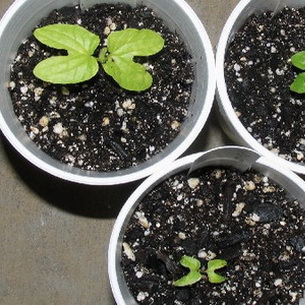
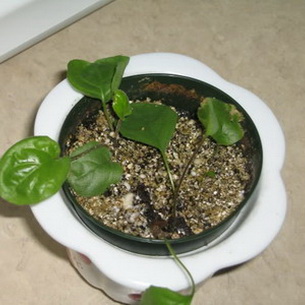


A lot of work and time is spent on vegetative reproduction, but all the qualities of the mother plant are transmitted to the offspring.
Gerbera can also be propagated by dividing the bush and grafting.
The division is suitable only for a form with a pronounced tillering ability (mainly a group of narrow-petal varieties). In this case, mother plants are removed from the ground, the roots and leaves are shortened, leaving up to 15 cm, the rhizome is divided into pieces with roots and at least one shoot. Places of cuts are sprinkled with charcoal powder and planted in pots with a diameter of 10 cm, watered and put under a film, shaded in sunny weather. Rooting occurs slowly, only after a month does the gerbera begin to grow normally.
After that, the plants are planted so that the rhizome is 5 cm above the substrate. Shoots begin to grow at a temperature of 22-24 ° C and an air humidity of 70-80%. These shoots are removed and rooted. Before planting the cuttings, the substrate is compacted, perlite is poured on top with a layer of 1–2 cm, the temperature is maintained at about 25 ° C, the air humidity is 80–90%. Roots are formed within four weeks. Plants are transplanted into pots with a diameter of 7 cm and placed under a film for growing. After four weeks, the seedlings are ready. New shoots are formed on the mother plants, so cuttings can be taken from them 3-4 times, but at the same time they are weaker. For grafting, a gerbera older than one year is used, with an already formed rhizome. It should be cut in March-April.
For rapid development on the cuttings of the root system, growth stimulants are used
The cuttings are slightly soaked first in a 0.01% solution of potassium permanganate, shake off the drops and immerse the bases in powder with a stimulant, and then carefully planted so that it does not crumble
This video shows the propagation of gerbera by cuttings:
Next, you will find out Jameson's indoor gerbera flower.
What does the gerbera symbolize: the legend and meanings of the flower
According to legend, the young nymph Herba was very beautiful, she was admired not only by young men, but also by girls. The modest nymph was tired of everyone's attention, and in order to get rid of it, she turned into an unassuming forest flower, as charming as a young beauty. This is how the gerbera arose, the meaning of the flower of which became modesty and innocence.Gerbera symbolizes purity, and it is appropriate to present a bouquet of it to people who are respected, appreciated and sincerely admired.
This is the legend about the origin of the plant's name. In fact, unknown flowers that grew in southern Africa were discovered by Dutch travelers. The first description of the gerbera flower was made in 1717 by the Dutch botanist Jan Gronovius, who in 1737 named it after his friend, German botanist and physician T. Gerber.
There is another version of the origin of the name of the plant - from the Latin word "herba", grass.
Gerbera indoor (home) in a pot, home care
Gerbera in a pot
If you were presented with a gerbera in a pot for your birthday or just for a holiday, you urgently need to learn the basics of caring for this beautiful flower so that it remains in the pot even after flowering.
Gerberas in a pot must be fertilized, but feeding is recommended before the end of the dormant period of the plant. In cases where rest came to your plant after flowering at your home, it recommends feeding using mineral fertilizers. The frequency of fertilizing gerberas is about twice a month, and gerberas must also be fed during the period of flowering, growth, etc.
With proper care, watering, at the correct temperature of the content of the plant, a gerbera growing in a pot will delight the eye with its beautiful flowering in the winter season. With improper care in winter, the gerbera will simply go into a so-called hibernation. All that the gerbera will do in winter, while in the so-called hibernation, is to overgrow with new leaves and accumulate strength for new flowering in the summer.
How to care for a gerbera at home?
It is impossible to grow gerberas in our climatic conditions, if only in greenhouses as an ordinary herbaceous, perennial plant. Outdoors as an annual plant. In winter, gerberas in the open field are not able to survive, so they are dug up in the autumn and placed in basements together with an earthen clod. But gerberas can also be grown at home, where they will delight the eye with their charming flowering, let's talk about growing and caring for gerberas at home.
Taking care of and generally growing gerberas at home is not difficult. However, there are still some secrets in care and cultivation. For example, you bought a gerbera in a store that was previously grown in a greenhouse, they are usually brought from Holland. This movement of the gerbera from her usual greenhouse environment to your apartment is a big "shock", especially since you should not transplant the gerbera into a new pot, it will be very difficult for the plant. The transplant can be carried out only after some adaptation time has passed. Typically, this period of getting used to new conditions takes about two weeks after purchasing the plant.
If your flower has been living for a long time, transplants should be carried out only in the spring. When transplanting, you should be as careful as possible with the root system of the gerbera, so as not to damage the roots, the transplant should be carried out with a lump of earth, and the pot should be one size larger, with a wide upper part. You should also make sure that there is good drainage at the bottom of the gerbera pot.
The soil mixture for gerbera should consist of slightly acidic soil, as well as sand, leafy earth and peat, everything should be in equal parts, except for leafy soil, it should be twice as much as the rest of the ingredients. You cannot use organic fertilizers when growing gerbera, this plant does not tolerate it.
After the gerbera has been transplanted into a new pot, he needs timely and abundant watering.
Diseases and pests
Causes of the disease:
- The appearance of pests.
- Lack of water or light.
- Bay.
- Excess light.
- Poor soil quality.
More information about room gerbera diseases can be found in this article.
Fungal diseases:
Gray rot. A common cause of death of gerberas. Infection occurs through water or soil, characterized by the appearance of a gray bloom in the upper part of the plant
When the first signs of the disease are detected, you can try spraying with Fundazol or Rovral, but in most cases the plant cannot be saved.
Important! The pathogen remains viable for a very long time - more than a year in the ground and plant debris, so it is better to immediately destroy the suspicious material.
Powdery mildew. The disease affects young growth: it is covered alternately with milky white, then gray bloom and slowly dries out
The pathogenic microorganism can be airborne, so it is important to maintain a quarantine regime when buying a new plant. Gerbera is rescued by fungicides Fundazol, Topaz.
If the plant begins to wilt sharply, and large depressed spots are found on the leaves, it was struck by sclerotinosis. This is due to an excess of moisture and overfeeding with organic fertilizers. Prevention: proper cultivation techniques. Change the substrate and reduce the frequency of watering. Fungicide for treatment - Vitaros.
Drying of the leaves (first from the outside, then from the inside of the outlet), dropping the flower and rotting roots indicate damage by late blight. This disease is most common in indoor plants. Disease prevention: correctly selected substrate (aerated and loose), moderate watering. Medicines - Previkur, Gold or Ridomil.
Cucumber mosaic. The plant develops necrosis: yellow-green spots that appear on the leaves gradually deform them. This disease is tolerated by aphids. Plants are especially defenseless at the end of the growing season. It cannot be cured, therefore, preventive actions for inspection and treatment with insecticides should be regular.
Pests
- Spider mite.
- Aphid.
- Whitefly.
All three species suck the sap out of the plant and multiply rapidly.
Treatment according to the following scheme:
- Pests and larvae are collected by hand.
- The plant is washed under a warm shower.
- Sprayed with soap or onion solution.
- It is treated with Aktellik, Neoron or other insecticide 2-3 times in a row.
Botanical description and history of origin
This plant is a herbaceous perennial from the Astrov family. The stem, from which the rosette with elongated leaf plates emerges, is located underground. Gerbera flower stalk grows without foliage, its height reaches 30-65 centimeters.
Most often, the flower basket is quite large, with tongue-shaped petals coming out of it. They can be located in one or several rows.
In appearance and structure of the baskets, gerberas are very reminiscent of chamomile. You can find these flowers in a wide variety of shades. But the most popular are the orange ones, the petals of which resemble tongues of flame.
Outdoors, gerberas can bloom throughout the summer season. After flowering, seed pods are formed, which ripen in late summer - early autumn.
If we talk about the history of the emergence of an African curiosity, then here it is worth remembering one beautiful legend. It says about one heavenly angel who once inflamed with feelings for an earthly girl. But this angel was well aware that they could not be together.
Therefore, I decided to present the girl with a gift in the form of a star glade. These stars have turned into orange gerberas. The girl, seeing her talent, simply smiled. Since that moment, these stars-lights have become a symbol of sincerity.
Diseases and pests
The capricious gerbera is susceptible to fungal diseases and putrefactive lesions. The most dangerous disease for a perennial is rotting of the root collar, which is caused by fungi.

Gray rot on the plant
However, excessive watering or moisture ingress into the outlet can also provoke plant pathology.Problems can be avoided by regular soil drainage. If it is not possible to save the affected plant, then it must be dug up and burned so that the disease does not spread to neighboring shrubs.
Gray rot, which can be recognized by the characteristic brown spots on the leaves, gray fluffy bloom, is also dangerous for gerbera. At first, it leads to decay of the foliage, and if untreated, the roots of the flower. They fight the disease with the help of fungicide preparations Teldor, Gamair, Skor and Discor emulsions.
The defeat of Fusarium is determined by characteristic signs: weakening of the plant, the appearance of brown spots and drying of the leaves on one side.
In the summer, the perennial is susceptible to infection with powdery mildew, which also occurs due to a lack of calcium in the soil, an excess of mineral fertilizers. On flowers and ornamental plants, dew is destroyed with the preparations Topaz, Chistotsvet, Skor.
Insect pests are eliminated using insecticide chemicals.
The main pests of gerbera, due to which the flower turns yellow and withers:
- spider mites (Aktellik, Neoron, Fitoverm)
- thrips (Regent, Pegasus)
- whitefly (Fufanon, Agrovertin)
- slobbering penny (Pyrethrum, Karbofos)
- aphids (Aktara, Fas, Confidor)
- slugs (collected and destroyed by hand)
Winter gerbera care
Breeders managed to develop varieties that can withstand temperatures as low as -10 ℃, but they also need shelter for the winter.
Speaking of whether a perennial is a gerbera or an annual, it should be said that everything depends on the climatic conditions of the region. In regions where winters are harsh, it is recommended to transplant the plants into containers - and move them indoors. At home, the plants will definitely survive the winter. In the southern regions, it is enough to cut the flower stalks, stop fertilizing, and reduce watering. The bushes should be covered with straw and fallen leaves before winter.

Florists advise placing pots with gerberas in rooms with low air humidity and a stable temperature.
Reproduction
Gerbera, like other representatives of Astro perennials, can be propagated by cuttings, dividing a bush or seeds.

Gerbera garden design
Vegetative way
The main breeding method for a bush is to divide an overgrown bush. It is used for reproduction of valuable plants, because it allows you to preserve varietal characteristics.

Gerbera seedlings
Dividing a bush is a reliable way to preserve the varietal characteristics of a flower. Rejuvenating division is shown for an adult plant at 3-4 years of age. This procedure is usually performed in early spring, separating a young shoot with 1-2 leaves from the mother bush. In this case, it is recommended to shorten the roots to 10 cm.
Rooting of the delenka takes 35 days on average. In this case, the gerbera rosette should not protrude more than 1 cm above the ground surface.
By cuttings
Cutting an already mature bush allows you to get a viable, high-quality planting material of the variety the gardener needs. After grafting, the shoots will give flowers the next year.

Yellow gerberas
In order to get cuttings you should:
1Dug out the bush, clean the root system of soil, rinse it with running water.
2 Remove the rosette of leaves.
3 Plant the accumulation of roots in a greenhouse, wait for the emergence of shoots from the axillary buds (this usually happens after 2 weeks).
4When the shoots are strong, they can be planted in open ground as cuttings.
How to grow seedlings by seed method
When buying seeds of a plant for germination, it is important to monitor their germination period - it is only 7 months. They are sown in early autumn or from January to March. African exotic seeds remain viable for 7-8 months

African exotic seeds
The seeds are not planted in open ground, but in boxes or tubs with loose soil, consisting of sod earth, leaf humus, sand, perlite and peat. Before planting, the soil substrate must be sterilized: calcined over a fire or treated with steam in a water bath.Expanded clay is usually placed at the bottom of the box as drainage.
A week before the intended planting, the seeds are wrapped in gauze or cloth soaked in a weak solution of potassium permanganate. Then the gauze is carefully squeezed out and stored in polyethylene for 1-2 days. This method allows you to achieve seedlings faster.
Perennials grown from seeds begin to bloom 10–12 months after planting.
The landing order is as follows:
1Seeds are scattered over the surface of the soil, a small layer of fine river sand is poured on top.
2Water the sowing and cover with plastic wrap or glass. A box with seedlings is placed in a warm place with diffused lighting.
3 In the morning and in the evening, the shelter is removed so that condensation does not form.
4 If necessary, the soil is sprayed with water at room temperature.
5In 10-12 days, when the first shoots appear, you need to switch to regular moderate watering. Since that time, the seedlings are no longer covered with a film.
6 Seedlings with a pair of leaves dive into a new box, planting them at a distance of 8–10 cm from each other.
7 A seedling with 6 leaves is ready for planting in the garden.
It is important to maintain good illumination of the seedlings - daylight hours are about 12 hours. With a short daylight hours in winter, artificial supplementary illumination with the help of fluorescent lamps is allowed
The only disadvantage of the seed propagation method is that it does not guarantee the preservation of the characteristics of the mother bush.

Ageratum: description, planting in open ground and caring for it at home (30+ Photos & Videos) + Reviews
Description and varieties
We recommend that you familiarize yourself
What is usually called a flower is actually a whole inflorescence-basket. It consists of a large number of medium-sized radially located flowers. Some of them are “tongues”. They are called "tongue" and are laid along the edges of the basket. Other corollas, similar to small tubes, are called "tubular". This species folds the middle of the inflorescence.
Depending on the color of the tubular flowers, the center is black-brown or yellow. In some gerbera flowers, the tongues are shaded with a lighter or darker, saturated tone. There are varieties with needle-like reed flowers.
Breeders have presented the world with many variety series with different characteristics. The diameter of the inflorescence can reach from 5 to 16 cm, the height of the peduncle is 20-65 cm. The color palette of the baskets includes cream, soft and hot pink, red, orange, yellow, cherry, raspberry, purple shades.
Gerbera Jameson is represented by a wide range of varieties - large and small-flowered, low and tall. Powerful varieties are used to make bouquets. Green-leaved gerbera (G. viridifolia) is the second most popular species of South African plant among florists. On its basis, varieties with a small (5-7 cm) inflorescence were bred.

Revolution bicolor
Indoor cultivars:
- Revolution is an ultra-early series among large-flowered potted gerberas. It takes up to 17 weeks from germination to the first inflorescences. Height - 10-15 cm. There are 12 variations of shades.
- Mega Revolution - large semi-double baskets on peduncles 15-25 cm long, before flowering - 4 months. 11 colors. Illumination: moderate, enough 3 hours in the sun.
- Mini Revolution has medium-sized baskets and blooms early. Shades: red, pink and white.
- Micro Revolution - miniature bushes with round inflorescences, more than 50% of which are semi-double and double. The manufacturer offers a series in a mixture called Irish Eyes (Irish Eyes).
- Festival F1 is a hybrid series 20-25 cm tall. Includes simple and semi-double flowers in 18 shades. Particularly interesting is the variety with spider-like baskets - Spider Salmon with Eye.
- Festinal Mini F1 - plants that need a pot of 9 cm in diameter.
- Majorette - represents bushes of uniform growth and flowering up to 25 cm. Contains 7 colorings of flowers with a dark center.
- Durora - a new series with terry baskets of tiled structure in red, orange, yellow, pink and cream shades with a diameter of 7 cm. Jaguar F1 - reaches 20-25 cm in height. Presented in 15 colors of delicate and rich tones.
- Cartwheel F1 features 10 cm baskets with a lot of reed flowers. The series includes 3 varieties: Autumn Colors - with a bright gamut (yellow, orange, red), Strawberry Twist - shades of pink (cream with a light pink, strawberry cream, deep pink), Chardonnay - fawn tones (ivory, cream, soft -peach).
Breeders continue to work on creating new varieties and improving the qualities of existing ones. Species with original shades and an unusual type of inflorescences are added to the register every year.

